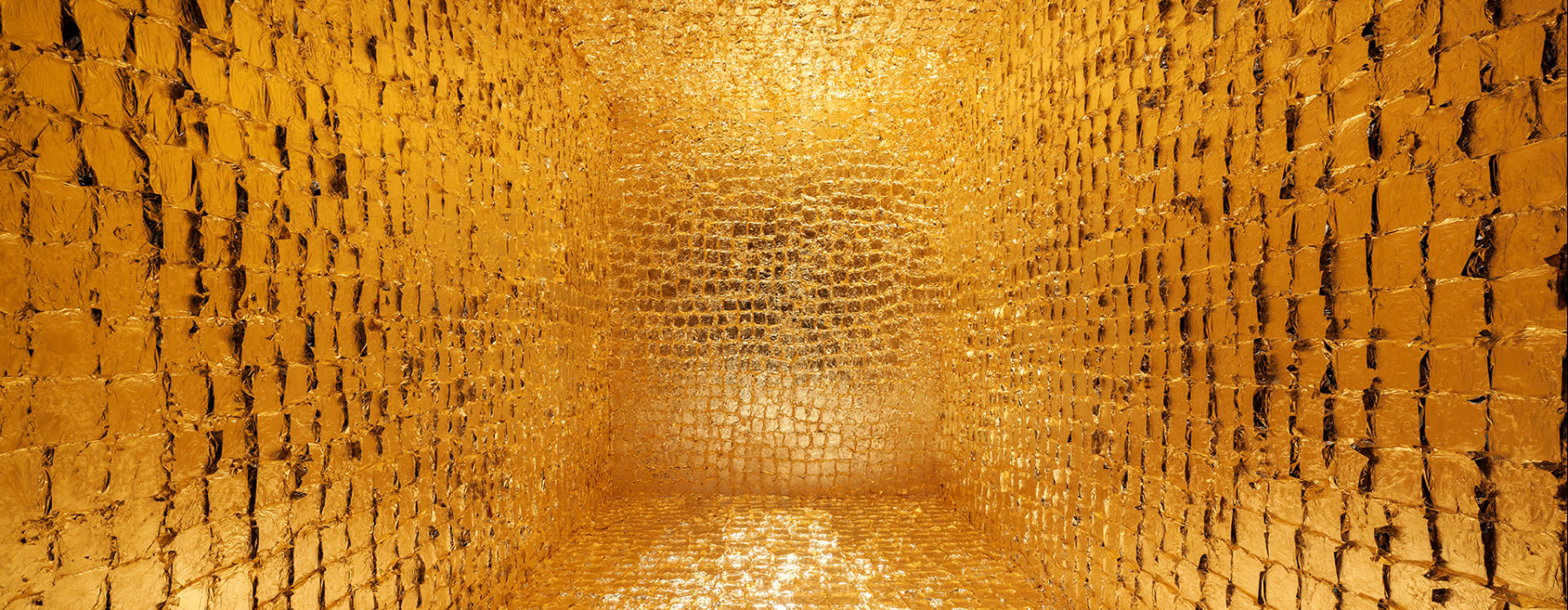
1 and 2. Two reliquaries
Gold, wood, metallic threat, glass and pearl beads; Netherlands; 1700-1750; courtesy of Stedelijk Museum Breda
The two baroque reliquaries contain relics of the skulls of the eleven thousand virgins who accompanied Saint Ursula on her pilgrimage to Rome. The fine handiwork on the skulls and the space surrounding them was done by nuns who specialised in such work. Two medallions have been carved out above and below the relics. The first reliquary is used to store relics of Saint Lawrence and Saint Teresa of Avila. The relic in the top of the second reliquary is unidentified. A small piece of Jesus’ manger in Bethlehem is kept in the bottom section.
3. Reliquary monstrance
Gilded copper; Belgium; c. 1880; courtesy of Stedelijk Museum Breda
This reliquary resembles a 19th-century neogothic church in terms of its shape and decoration. Behind the glass there are fragments of the arm bones of Saint Vincent de Paul and Saint Fidelis of Sigmaringen, who both lived around 1600. Saint Vincent was known for his acts of charity. Saint Fidelis was a priest who was murdered in Switzerland in 1622.
4. Reliquary monstrance
Gold, silver, enamel; Germany; 1300-1349; courtesy of Museum Catharijneconvent
This priceless reliquary, which was used for storing the teeth of a saint until at least 1566, is part of the ecclesiastical treasure of Saint Lebuinus’ Church in Deventer. The teeth would have been clearly visible to the congregation.
5. Tower reliquary
Gilded copper; probably Belgium; 1800-1900; courtesy of Stedelijk Museum Breda
This tower reliquary still contains the original relic, which comes from none other than John the Baptist, according to the note. John baptised Jesus in the river Jordan. The decorative cross on the pointed roof refers to the crucifixion of Christ.
6. Monstrance
Gold, copper; Netherlands; 1500-1599; courtesy of Museum Catharijneconvent
This Roman Catholic monstrance displays the host – a disc of unleavened bread used during mass, which commemorates the crucifixion of Jesus with offerings of bread (the host) and wine. The bread is believed to transform into the body of Christ. The host is therefore sacred. This is why monstrances are lavishly decorated, often with gold. The stem features the heads of angels.
7. Chalice
Gold, silver; Netherlands; c. 1500; courtesy of Museum Catharijneconvent
This chalice would stand on the altar during the Roman Catholic mass. It contained wine, representing the blood of Christ, which the priest would offer to God. During mass, Catholics commemorate the crucifixion of Jesus with offerings of bread (the host) and wine. The Latin inscription on the chalice means, ‘Hail Mary, full of grace, the Lord is with thee’. The worship of Mary was particularly popular in the Late Middle Ages.
8. Candle
Glass, paint, candlewax; Mexico; 1980; purchased from J.J. Leyenaar; RV-5069-272
Candlelight symbolises divine light, so candles are commonly found in churches and temples, and on graves. The glass has a painted image of Santa Muerte, a Mexican Catholic saint. She is acknowledged as the patron saint of marginalised people such as criminals, sex workers and members of the LGBTQ+ community.
9. Reliquary
Gilded wood, iron; Japan; 1800-1829; purchased from P.F.B. von Siebold; RV-1-3575
One of the distinctive features of the Buddha was that he was born with golden skin. Gold symbolises enlightenment and purity, including in Japanese Buddhism. Buddhist reliquaries are therefore often made of gold.
10. Handwritten Qur’an
Gold leaf, paper, leather, cotton, textile, ink, paint; Aceh, Indonesia; before 1872; gift of J.J. Korndöffer; WM-7496
This Qur’an is lavishly decorated with gold leaf. Calligraphy is the highest form of art in the Muslim world, used to honour the word of God in the Qur’an. This manuscript comes from India, but the binding is from Indonesia.
11. The Poem of the Cloak
Gold paint, paper, gouache; Lebanon; 1865; purchased from F. de Jong; 7031-22; courtesy of the Mondrian Fund
This manuscript is divided into three zones. At the top is the bismillah, the phrase recited by Muslims before performing a good act. In the central section are the 201 names of the Prophet Mohammed, and the bottom section contains lines from The Poem of the Cloak, an ode to the Prophet Mohammed by 13th-century Sufi poet Al-Busiri. Most of the 201 names of the Prophet Mohammed come from the Qur’an. They underline the prophet’s many and varied qualities. The verses are believed to have supernatural powers, and are used as an amulet.
12. Qur’an
Paper, gold, silk brocade; Iran; 16th century; WM-64826
This 16th-century Qur’an is written in rihani (which literally means ‘sweet-smelling’). This script was introduced for making Qur’ans in the second half of the 13th century. It is a smaller form of the muhaqqaq script, and it was used for transcribing Qur’ans in Iran until the 20th century. The margins surrounding the text are decorated with red, blue and gold floral motifs, similar to those seen in copies of the medieval Christian Book of Hours.